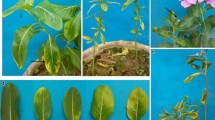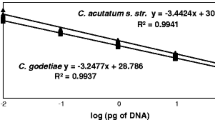Abstract
Bacteria serologically related to Leifsonia xyli ssp. xyli, the causal bacterium of ratoon stunting disease (RSD) in sugarcane, were detected using the fluorescent antibody direct count on filter (FADCF) technique in grasses in eastern Australia. In a survey of 191 grass, sedge and bullrush samples comprising 53 plant species, 90 (47%) of the samples tested harboured bacteria which reacted positively with L. xyli ssp. xyli polyclonal antiserum. A total of 18 grass species was found to be naturally colonised with bacteria serologically related to and morphologically similar to L. xyli ssp. xyli. Grasses colonised by these L. xyli-like bacteria were present in areas both adjacent to, and removed from, sugarcane crops. When L. xyli-like bacteria from Rhodes grass (Chloris gayana) were inoculated into sugarcane, they multiplied at a lower rate than L. xyli ssp. xyli. L. xyli-like bacteria in Rhodes grass were isolated in axenic culture and exhibited growth rates, colony size and pigmentation similar to those of L. xyli ssp. cynodontis, a bacterial pathogen of Cynodon dactylon (couch grass). Further, using a polymerase chain reaction (PCR) test that could differentiate L. xyli spp. xyli from L. xyli spp. cynodontis, the L. xyli-like bacteria infecting Rhodes grass, couch grass and panic grass (Panicum maximum) generated a product of the same size as L. xyli spp. cynodontis. We conclude that L. xyli ssp. cynodontis or closely related bacteria are common endophytes of grasses in eastern Australia.
Similar content being viewed by others
References
Barbehenn RV, Purcell AH (1993) Factors limiting the transmission of a xylem-inhabiting bacterium Clavibacter xyli subsp. cynodontis to grasses by insects. Phytopathology 83, 859–863.
Croft BJ, Witherspoon JR (1982) Molded unit for positive pressure extraction of ratoon stunting disease bacteria. Sugarcane Pathologists’ Newsletter 28, 33–34.
Croft BJ, Teakle DS, Leaman TM (1993) Serological diagnostic tests for ratoon stunting disease in sugarcane. Instruction Manual MN93001.
Davis MJ, Dean JL (1984) Comparison of diagnostic techniques for determining incidence of ratoon stunting disease of sugarcane in Florida. Plant Disease 68, 896–899.
Davis MJ, Dean JL, Harrison NA (1988a) Distribution of Clavibacter xyli subsp. xyli in stalks of sugarcane cultivars differing in resistance to ratoon stunting disease. Plant Disease 72, 443–448.
Davis MJ, Dean JL, Harrison NA (1988b) Quantitative variability of Clavibacter xyli subsp. xyli populations in sugarcane cultivars differing in resistance to ratoon stunting disease. Phytopathology 78, 462–468.
Davis MJ, Lawson RH, Gillaspie AG, Harris RW (1983) Properties and relationships of two xylem-limited bacteria and a mycoplasmalike organism infecting bermuda grass. Phytopathology 73, 341–346.
Davis MJ, Gillaspie AG, Vidaver AK, Harris RW (1984) Clavibacter: a new genus containing phytopathogenic coryneform bacteria, including Clavibacter xyli subsp. xyli sp. nov. and Clavibacter xyli subsp. cynodontis subsp. nov., pathogens that cause ratoon stunting disease of sugarcane and bermudagrass stunting disease. International Journal of Systematic Bacteriology 34, 107–117.
Dominiak BC, Sinnamon LR, Jones CD, Taylor PWJ (1992) RSD control in Bingera mill area and problems encountered. Proceedings of Australian Sugar Cane Technologists pp. 37–42.
Evtushenko LI, Dorofeeva LV, Subbotin SA, Cole JR, Tiedje JM (2000) Leifsonia poae gen. nov., sp. nov., isolated from nematode galls on Poa annua, and reclassification of ‘Corynebacterium aquaticum’ (Leifson 1962) as Leifsonia aquatica (ex Leifson 1962) gen. nov., nom. rev., comb. nov. and Clavibacter xyli (Davis et al. 1984) with two subspecies as Leifsonia xyli gen. nov., comb. nov. International Journal of Systematic and Evolutionary Microbiology 50, 371–380.
Fegan M, Croft BJ, Teakle DS, Hayward AC, Smith GR. (1998) Sensitive and specific detection of Clavibacter xyli subsp. xyli, causal agent of ratoon stunting disease of sugarcane, with a polymerase chain reaction-based assay. Plant Pathology 47, 495–504.
Gillaspie AG, Teakle DS (1989) Ratoon stunting disease. In ‘Diseases of sugarcane’, Vol 1. (Eds C. Ricaud, B.T. Egan, A.G. Gillaspie and C.G. Hughes) pp. 59–80. (Elsevier: Amsterdam)
Hughes CG, Steindl DRL (1955) Ratoon stunting disease of sugarcane. Queensland Bureau of Sugar Experiment Stations Technical Communication No. 2.
Koike H, Gillaspie AG, Benda TA (1982) Cane yield response to ratoon stunting disease. International Sugar Journal 84, 131–133.
Liao CH, Chen TA (1981) Isolation, culture and pathogenicity to sudan grass of a corynebacterium associated with ratoon stunting of sugarcane and with bermuda grass. Phytopathology 71, 1303–1306.
Matsuoka S (1971) Elephant grass, an indicator plant for ratoon stunting virus of sugarcane. FAO Plant Protection Bulletin 19, 110–115.
Riley IT, Ophel KM (1992) Clavibacter toxicus sp. nov., the bacterium responsible for annual ryegrass toxicity in Australia. International Journal of Systematic Bacteriology 42, 64–68.
Steindl DRL (1957) Host range of the sugarcane ratoon stunting disease virus. The Journal of the Australian Institute of Agricultural Science 23, 238.
Steindl DRL (1961) Ratoon stunting disease. In ‘Sugarcane diseases of the World’. (Eds J.P. Martin, E.V. Abbott, and C.G. Hughes) pp. 433–459. (Elsevier, Amsterdam)
Steindl DRL, Teakle DS (1974) Recent developments in the identification of ratoon stunting disease. Proceedings of the Queensland Society of Sugar Cane Technologists 41, 101–104.
Taylor PWJ, Ryan CC, Birch, RG (1988) Harvester transmission of leaf scald and ratoon stunting disease. Sugar Cane No. 4, pp. 11–14.
Author information
Authors and Affiliations
Corresponding author
Rights and permissions
About this article
Cite this article
Mills, L., Leaman, T.M., Taghavi, S.M. et al. Leifsonia xyli-like bacteria are endophytes of grasses in eastern Australia. Australasian Plant Pathology 30, 145–151 (2001). https://doi.org/10.1071/AP01003
Received:
Accepted:
Issue Date:
DOI: https://doi.org/10.1071/AP01003




